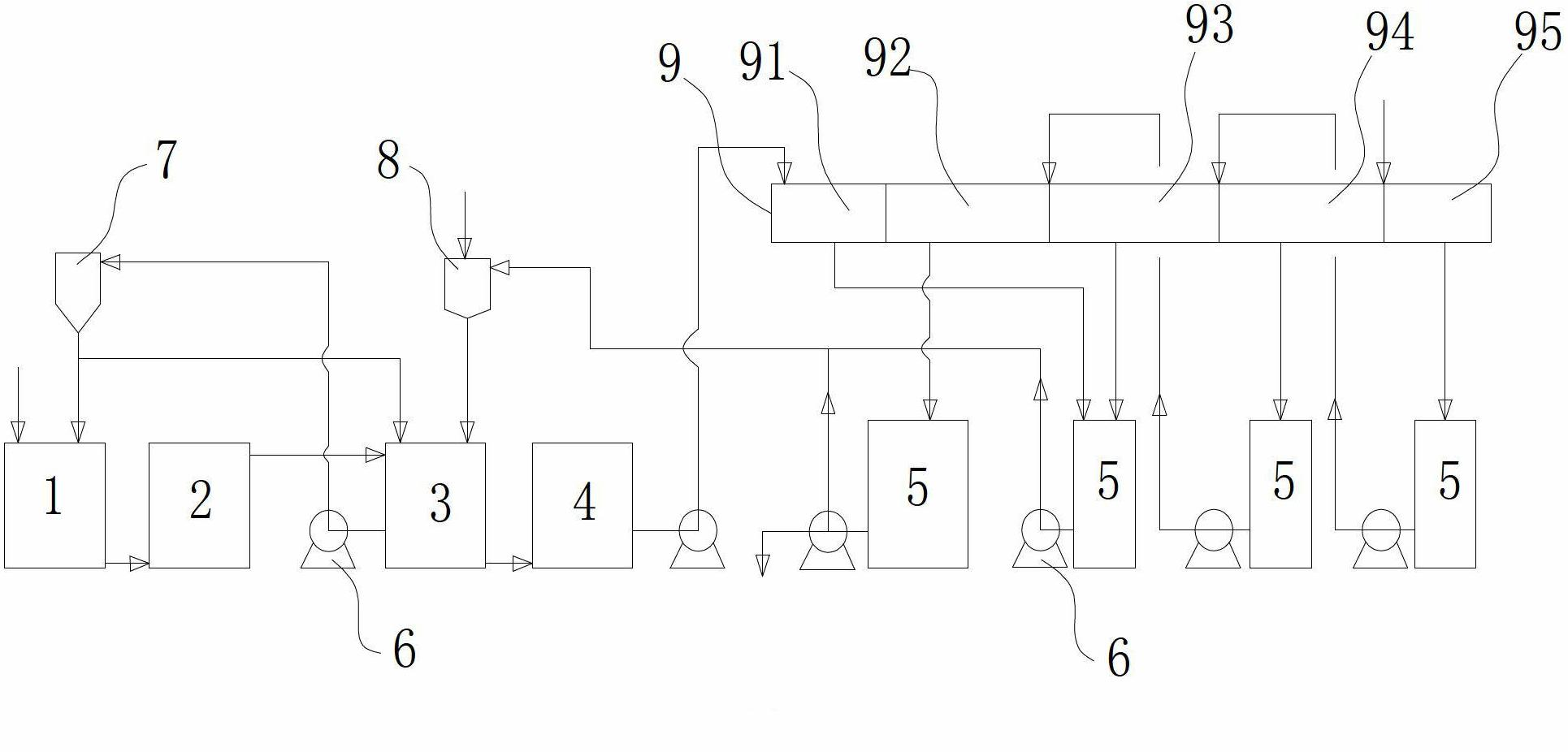Method for producing phosphoric acid by hemihydrate technique
A phosphoric acid and process technology, applied in chemical instruments and methods, phosphorus compounds, inorganic chemistry, etc., can solve the problem of unfavorable phosphate rock fully reacting to the growth of calcium sulfate hemihydrate crystals, inconvenient for phosphogypsum transport, transportation and recycling, filtration and separation, and Problems such as poor washing effect, to achieve the effect of convenient semi-aqueous reaction temperature, simplified and stable operation control, and stable semi-aqueous reaction temperature
- Summary
- Abstract
- Description
- Claims
- Application Information
AI Technical Summary
Problems solved by technology
Method used
Image
Examples
Embodiment 1
[0061] The method is carried out in the following steps: premixing of phosphate rock and slurry return, decomposition of phosphate rock, crystallization and slurry return, crystal growth, filtration and washing, and acid return.
[0062] The indicators of phosphate rock for production are as follows:
[0063] P 2 o 5 %
CaO%
MgO%
h 2 O%
Fe 2 o 3
al 2 o 3
Acid insoluble %
33.05
48.21
0.76
12.97
0.46
0.47
5.6
[0064] 1. Phosphate rock is premixed with the return slurry from the crystallization tank 3
[0065] The phosphate rock powder feeds continuously at 80t / h into the premixing tank 1, and the slurry from the crystallization tank 3 cooled by the flash evaporator 7 feeds at 1000m 3 Enter in / h, premix and react in premix tank 1, the reaction temperature is 90°C, and the indicators in the premix tank are as follows:
[0066]
[0067] The return index is as follows:
[0068] ...
Embodiment 2
[0078] The method is carried out in the following steps: premixing of phosphate rock and slurry return, decomposition of phosphate rock, crystallization and slurry return, crystal growth, filtration and washing, and acid return.
[0079] The indicators of phosphate rock for production are as follows:
[0080] P 2 o 5 %
CaO%
MgO%
h 2 O%
Fe 2 o 3
Al 2 o 3
Acid insoluble %
32.5
47.6
1.40
13.4
0.8
0.5
5.4
[0081] 1. Premixing of phosphate rock and return slurry
[0082] Phosphate rock powder feed rate is 85t / h, 1150m 3 The amount of pulp return per hour is pre-reacted in the premixing tank 1, the reaction temperature is 95°C, and the indicators in the premixing tank 1 are as follows:
[0083] P 2 o 5 %
CaO%
slurry ratio
filtrate acid
Solid content
[0084]
Heavy
%
43.35
1.01
1.76...
example 3
[0096] The method is carried out in the following steps: premixing of phosphate rock and slurry return, decomposition of phosphate rock, crystallization and slurry return, crystal growth, filtration and washing, and acid return.
[0097] The indicators of phosphate rock for production are as follows:
[0098] P 2 o 5 %
CaO%
MgO%
h 2 O%
Fe 2 o 3
Al 2 o 3
Acid insoluble %
34.36
48.23
1.17
12.95
0.46
0.81
6.4
[0099] 1. The amount of phosphate rock powder is 78t / h, 1000m 3 The amount of slurry returned per hour is pre-reacted in the premixing tank 1, the reaction temperature is 97°C, and the indicators in the premixing tank 1 are as follows:
[0100]
[0101] The return index is as follows:
[0102]
[0103] 2. Decomposition of phosphate rock
[0104] The semi-aqueous slurry overflows to the decomposition tank 2 for further decomposition reaction, and the reaction temperatur...
PUM
 Login to View More
Login to View More Abstract
Description
Claims
Application Information
 Login to View More
Login to View More - R&D Engineer
- R&D Manager
- IP Professional
- Industry Leading Data Capabilities
- Powerful AI technology
- Patent DNA Extraction
Browse by: Latest US Patents, China's latest patents, Technical Efficacy Thesaurus, Application Domain, Technology Topic, Popular Technical Reports.
© 2024 PatSnap. All rights reserved.Legal|Privacy policy|Modern Slavery Act Transparency Statement|Sitemap|About US| Contact US: help@patsnap.com










